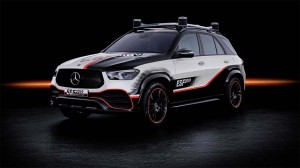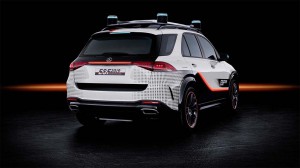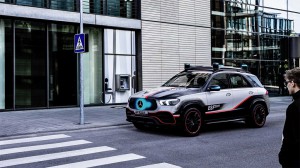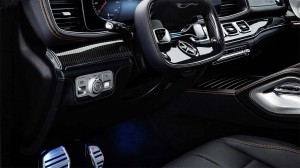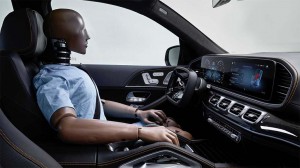The new Mercedes-Benz ESF 2019 started life out as just another midsize crossover, but the familiar GLE has undergone an array of modifications that could significantly improve the safety of passengers and pedestrians, the German automaker says.
These include changes to airbags, seatbelts and a child safety seat meant to make them more effective in a crash, as well as a steering wheel and pedals that retract when the ESF is operating in autonomous mode, and even an outside communications system meant to signal pedestrians and bicyclists what the vehicle is going to do next. There’s even a built-in robot that pops out of the back of the vehicle to warn oncoming traffic in the event of a crash.
Some of the more than a dozen different innovations “are very close to series production,” said Ola Kallenius, the Daimler AG Executive Board member overseeing Mercedes-Benz Cars Development, though others “look well into the future.”
The ESF is the latest in a long-running series of experimental safety vehicles from the German manufacturer. It’s set to make its debut at a safety conference in Eindhoven, Germany, next month, with a public introduction at the Frankfurt Motor Show three months later.
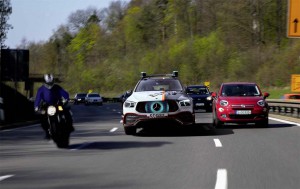
The new ESF 2019 is designed to ensure the safety of passengers as well as pedestrians and other vehicles.
(Mercedes-Benz taking orders for new EQC electric crossover. Click Here for the story.)
“Safety is part of the brand DNA of Mercedes-Benz,” added Kallenius, who will soon become the company’s CEO. “We have repeatedly demonstrated that we are not short of ideas in this field since the 1970s, with our Experimental Safety Vehicles. The new ESF 2019 reflects the mobility of the future, and presents a wide variety of innovations which we are currently researching and developing.”
Some of the features on the Mercedes-Benz ESF start out as familiar safety devices. But the front seatbelts now can signal a driver that they may be entering a curve too rapidly by tightening up. And by heating the rear belts, while also building USB ports into them, the automaker hopes to increase their usage. Meanwhile, a new design for child safety seats should help keep an infant more firmly in place, reducing the risk of injury in a crash.
More and more of today’s vehicles are equipped with active safety and advanced driver assistance systems. The technology on the ESF is meant to add even more intelligent controls. That includes the Active Brake Assist system which comes into play, “especially in potentially dangerous traffic situations with unprotected road users,” the automaker explained.
(Click Here to learn how Mercedes is leading in U.S. luxury car sales.)
“When turning, it now also detects pedestrians and cyclists moving in parallel to the original direction of travel. If a collision with unprotected road users crossing the road into which the vehicle is turning is imminent, the driver receives a visual and audible warning. Autonomous braking is initiated if the driver fails to react. The same also applies if there are any cyclists in the blind spot when turning to the right.
The plug-in hybrid explores how safety features might be updated when a vehicle is operating in autonomous mode. Among other things, the ESF’s steering wheel and pedals retract to reduce injuries to the driver in the event of the crash.
A human motorist can communicate with other drivers, as well as bicyclists and pedestrians, even if with just a wave or a nod. The ESF explores ways for an autonomous vehicle to communicate when there’s no driver behind the wheel. In the ESF that includes special lighting on the grille and tail, a digital message board built into the rear glass, and a pop-up warning sign on the roof. There’s even that little robot that can roll out and turn into a warning triangle in the event of a crash or some other emergency.
(To see more about Daimler’s earnings falling 37% due to a drop in Mercedes sales, Click Here.)
“The great advantage of automating driving functions is that in the future, fewer accidents will be caused by driver error,” said Rodolfo Schöneburg, head of the Vehicle Safety, Durability and Corrosion Protection Center at Mercedes-Benz Cars. “However, automated and driverless vehicles also come up against physical limits, and there will undoubtedly be mixed traffic consisting of automated and non-automated vehicles for many years.”

